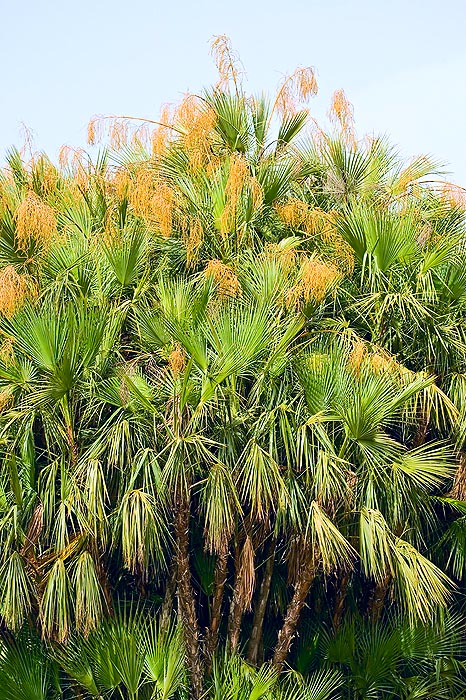Family : Arecaceae

Text © Pietro Puccio

English translation by Mario Beltramini

Up to 8 m tall, cespitose, thin trunks. Little cultivated © Giuseppe Mazza
Acoelorrhaphe wrightii (Griseb. & H.Wendl.) H.Wendl. ex Becc. (1907) is native to southern Florida (USA), Cuba, Bahamas and the Atlantic coast of Central America, from southern Mexico to Colombia, where it grows mainly in swamps close to the seaside.
The name of the genus comes from the Greek “a” (without), “coelos” = hollow and “raphé” = raphe, with reference to the absence of the depression present on the seeds of similar genera. The species is named after the America botanist Charles Wright.
It is known with the common names of guano preto (Cuba), tasiste (Mexico), tique (Honduras), palma de pantano (Venezuela), paurotis palm, Everglades palm, saw cabbage palm (USA).
Cespitose palm, with thin trunks, reddish, 5-15 cm of diameter, up to 7-8 metres tall, covered with the persistent foliar bases.
The leaves are palmate, 50-90 cm of diameter, with a lamina light green above and slightly silver underneath and bifid segments at the extremity; the petiole, long up to 90 cm, has triangular thorns along the edges.
Monoecious palm, with interfoliar inflorescence longer than the leaves. The bisexual flowers, minute, are of a creamy colour and are disposed in groups of 2-3. The fruits are little, globous, of about 12 mm of diameter, of orange colour, turning to black at maturity. Acoelorraphe wrightii has most recently been assessed for The IUCN Red List of Threatened Species in 2016 and is listed as “LC, Least Concern“.
It propagates by seed, which takes about three months for germinating, and, with some difficulty, by division.
Not much utilized plant outside its native area, in spite of its quite non indifferent ornamental value.
Can be cultivated in the tropical, subtropical and mild zones (where it resists to temperatures up to about -6 °C), in full sun and sandy, constantly wet soils; it adapts also to normal soils, provided they are irrigated, but with a generally slower growth.
Synonyms: Copernicia wrightii Griseb. & H.Wendl. (1866); Paurotis wrightii (Griseb. & H.Wendl.) Britton (1908); Serenoa arborescens Sarg.(1899); Paurotis androsana O.F.Cook, (1902); Paurotis arborescens (Sarg.) O.F.Cook (1902); Acoelorrhaphe wrightii var. novogeronensis Becc. (1907); Acoelorrhaphe arborescens (Sarg.) Becc.(1908); Acanthosabal caespitosa Prosch. (1925); Brahea psilocalyx Burret (1934); Acoelorrhaphe pinetorum Bartlett (1935); Paurotis schippii Burret (1935); Paurotis psilocalyx (Burret) Lundell (1961); Acoelorrhaphe wrightii f. inermis Hadac (1970).
→ For general notions about ARECACEAE please click here.
